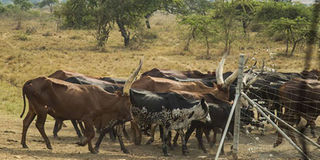Ministry races to curb Rift Valley fever as death toll hits 26

Rift Valley fever is a disease that mainly affects livestock. FILE PHOTO | NATION MEDIA GROUP
What you need to know:
- The Health ministry report says males were the most affected, at 70 per cent. The most affected age group is 21-30 years.
- The report said the outbreak was prevalent in insecurity-prone regions and this might make it difficult to contain the virus.
- The ministry has provided 500,000 doses of RVF vaccine to high-risk counties based on risk analysis
Seven more people have died of Rift Valley fever, bringing the toll to 26 in the past one month, a report from the Ministry of Health’s Disease Surveillance and Response Unit says.
Six people died in Wajir while one person succumbed in Marsabit. Some 24 cases were reported in Wajir and two in Marsabit.
Siaya County on Friday issued an alert after one person died from the mosquito-born disease, which was confirmed by tests at the Kenya Medical Research Institute (Kemri).
“Tests for Ebola and Marburg virus were negative,” Dr Omondi Owino, Siaya’s chief officer for Health, said.
VULNERABLE
The Health ministry report says males were the most affected, at 70 per cent. The most affected age group is 21-30 years.
Based on enhanced surveillance of Rift Valley fever-like syndromes in humans and livestock, six counties have been identified as having the highest risk of an outbreak, including Tharaka-Nithi, Garissa, Tana River, Lamu, Garissa, Kajiado and Baringo.
Mombasa and Nairobi are on heightened alert due to the risk of imported human and animal cases.
The outbreak was first reported in Eldas Sub-County, Wajir, with a sample sent to Kemri testing positive for the virus on June 7.
TEXTING
The report said the outbreak was prevalent in insecurity-prone regions and this might make it difficult to contain the virus.
“The communities are hard to reach (due to their nomadic lifestyle) and they depend majorly on animal products and have difficulties in accessing alternative diets,” the report said.
The ministry has formed a team of experts from government and non-governmental organisations to provide technical guidance to counties.
“Counties affected have been directed to send blood specimens to Kemri for confirmation while the ban on movement and slaughter of animals from the affected and at-risk counties put in place,” Dr Okunga said.
VACCINES
The ministry has provided 500,000 doses of RVF vaccine to high-risk counties based on risk analysis while the indoor residual spraying and animal spraying with pyrethroids is being carried out at the epicentre.
However, vector surveillance and control for humans and animals in high-risk counties are yet to start.
“This will start soon. We are going to ensure that the surveillance starts as soon as possible and investigation teams sent out to all high-risk counties to provide technical guidance before the outbreak,” he said.
Rift Valley fever is a disease that mainly affects livestock while people are mainly infected as a result of handling sick animals – either slaughtering them or assisting animals while giving birth.
PREVENTION
The other mode of transmission from animals, which is relatively low, is by mosquitoes and bites from other insects.
The disease causes abortion in animals.
Dr Okunga cautioned residents not to directly handle sick animals or slaughter them without consulting veterinary or public health officers.
Residents have also been encouraged to use mosquito nets.
“Anyone with a sick animal – mainly sheep and cows – must report to nearest authorities immediately and cases of abortions or loss of pregnancy in these animals must be reported too,” he said.





